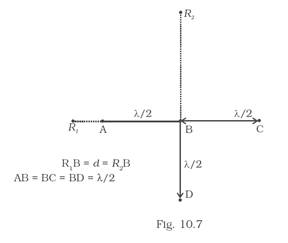Four identical monochromatic sources A, B, C, D as shown in the (Fig.10.7) produce waves of the same wavelength and are coherent. Two receiver R1 and R2 are at great but equal distances from B.

(i) Which of the two receivers picks up the larger signal?
(ii) Which of the two receivers picks up the larger signal when B is turned off?
(iii) Which of the two receivers picks up the larger signal when D is turned off?
(iv) Which of the two receivers can distinguish which of the sources B or D has been turned off?
(i) Let the wave at R1 because of A be, ![]()
The path difference of B with A is λ /2, i.e. phase difference is π
∴, the wave at B because of R1 is ![]()
The path difference of C with A is λ i.e. phase difference is 2π
∴, the wave at B because of R1 is ![]()
The path difference of D with A is



![]()
∴ the phase difference here is π
The wave D can be represented as
![]()
∴ the signal at R1 due to all sources Y1=A+B+C+D
![]()
Let the signal received by R2 because of B be
![]()
The path difference of D with B is λ/2
∴ i.e. phase difference is π
∴, the wave at D because of R2 is ![]()
The path difference of A with B is



![]()
∴ the phase difference here is 0
The wave A can be represented as
![]()
Similarly wave C can be represented as
![]()
∴ the signal at R2 due to all sources Y2=a+b+c+d
![]()
![]()
![]()
∴ R1 picks up larger signal
(ii) If B is switched off,
![]()
![]()
![]()
![]()
Thus R1 and R2 picks same signal
(iii) If D is switched off,
![]()
![]()
![]()
![]()
Thus R2 picks larger signal
(iv) A signal at R1 indicates B has been switched off and an
enhanced signal at R2 indicates D has been switched off